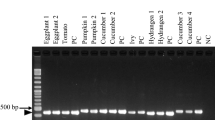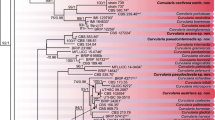Abstract
Random amplified polymorphic DNA (RAPD) and isoenzyme polymorphisms among 16 isolates of the postharvest pathogen Gilbertella persicaria were examined. Six different 10-bp primers were used to determine the extent of intraspecific genetic variability. Nine composite amplification types were identified. RAPD markers were obtained which correlated with the mating types of the G. persicaria isolates. The variability of the isoenzyme patterns was very low and no correlation was found between the isoenzyme markers and the mating abilities. When 80 single carbon substrates were tested in utilization assays, most of them were utilized uniformly by the 16 G. persicaria strains. However, some compounds elicited differences between the isolates representing the two mating types. β-Alanine (0.2%) has little effect on the germination of the sporangiospores of the (+) isolates, but inhibited the germination of (–) sporangiospores. Glycerol-1-monoacetate supported the growth of both mating types, but at concentrations higher than 4% this was accompanied with a compact (colonial) growth for plus mating type isolates only.
Similar content being viewed by others
References
Beauchamp C & Fridovich J (1971) Superoxide dismutase: improved assays and an assay applicable to acrylamid gels. Anal. Biochem. 44: 276-287
Benny GL (1991) Gilbertellaceae, a new family of the Mucorales (Zygomycetes). Mycologia 83(2): 150-157
Brewer GJ (1970) An Introduction to Isoenzyme Techniques. Academic Press, New York
Burmester A & Wöstemeyer J (1994) Variability in genome organization of the zygomycete Parasitella parasitica. Curr. Genet. 26: 456-460
Davis BJ (1964) Disc electrophoresis-II. Method and application to human serum proteins. Ann. NY Acad. Sci. 121: 404-423
Díaz-Mínguez JM, López-Matas MA & Eslava AP (1999) Complementary mating types of Mucor circinelloides show electrophoretic karyotype heterogenity. Curr. Genet. 36: 383-389
Ginting C, Zehr EI & Westcott SW III (1996) Inoculum sources and characterisation of isolates of Gilbertella persicaria from peach fruit in South Carolina. Plant. Dis. 80: 1129-1134
Hänfler J, Tepe H, Weigel C, Kruft V, Lurz R & Wöstemeyer J (1992) Circular extrachromosomal DNA codes for a surface protein in the (+) mating-type of the zygomycete Absidia glauca. Curr. Genet. 22: 319-325
Harris H & Hopkinson DA (1976) Handbook of Isoenzyme Analysis in Human Genetics. Elsevier North Holland, Amsterdam
Hesseltine CW (1960) Gilbertella gen. nov. (Mucorales). Bull.Torrey Bot. Club 87: 21-30
Kayser T & Wöstemeyer J (1991) Electrophoretic karyotype of the zygomycete Absidia glauca: evidence for differences between mating types. Curr. Genet. 19: 279-284
Leach J, Finkelstein DB & Rambosek JA (1986) Rapid miniprep of DNA from filamentous fungi. Fungal Genet. Newslett. 33: 32-33
Mehrotra BS & Mehrotra MD (1963) A morphological and physiological study of Gilbertella in India. Mycologia 55: 582-594
Mehrotra MD 1963. Fruit rot of tomato caused by Gilbertella persicaria var. indica. Sydowia 17: 124-125
Michailides TJ, Guo L-Y & Morgan DP (1997) Factors affecting zygosporogenesis in Mucor piriformis and Gilbertella persicaria. Mycologia 89(4): 603-609
Mulvey M & Vrijenhoek RC (1981) Genetic variation among laboratory strains of the planorbid snail Biomphalaria glabrata. Biochem. Genet. 19: 1169-1182
O'Donnell KL, Ellis JJ, Hesseltine CW & Hooper GR (1977) Zygosporogenesis in Gilbertella persicaria. Can. J. Bot. 55: 662-675
Papp T, Vágvölgyi Cs, Kerényi Z, Nagy Á & Michailides TJ (1997) DNA amplification polymorphisms of the postharvest pathogen Mucor piriformis. Antone van Leeuwenhoek 72: 167-173
Podani J (1993) SYN-TAX-pc, Computer programs for multivariate data analysis in ecology and systematics. Version 5.0. User's Guide. Scientia Publishing, Budapest, Hungary.
Sneath PHA & Sokal RR (1973) Numerical Taxonomy. W.H. Freeman, San Francisco, CA
Vágvölgyi Cs, Magyar K, Papp T, Palágyi Zs, Ferenczy L & Nagy Á (1996a) Value of substrate utilization data for characterization of Mucor isolates. Can. J. Microbiol. 42: 613-615
Vágvölgyi Cs, Papp T, Palágyi Zs & Michailides TJ (1996b). Isozyme variation among isolates of Mucor piriformis. Mycologia 88: 602-607
Williams JGK, Kubelik AR, Livak KJ, Rafalski JA & Tingey SV (1990) DNA polymorphisms amplified by arbitrary primers are useful as genetic markers. Nucleic Acids Res. 18: 6531-6535
Woodbury WA Spencer K & Stanmann MA (1971) An improved procedure using ferricyanide for detecting catalase isozymes. Anal. Biochem. 44: 301-305
Wöstemeyer J (1985) Strain-dependent variation in ribosomal DNA arrangement in Absidia glauca. Eur. J. Biochem. 146: 443-448
Author information
Authors and Affiliations
Corresponding author
Rights and permissions
About this article
Cite this article
Papp, T., Vastag, M., Michailides, T.J. et al. Genetic variability of the postharvest pathogen Gilbertella persicaria: identification of randomly amplified polymorphic DNA (RAPD) markers correlating with (+) and (–) mating types. Antonie Van Leeuwenhoek 80, 301–309 (2001). https://doi.org/10.1023/A:1013066024258
Issue Date:
DOI: https://doi.org/10.1023/A:1013066024258




